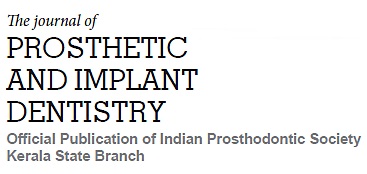Probiotics in Prosthodontics: A Paradigm Shift in Oral Health
Probiotics are live microorganisms, typically bacteria
and yeasts, that offer positive health benefits when
administered in sufficient quantities. They are
frequently associated with gut health, but they
have also been recognised for their positive impact
on oral health. Probiotics are beneficial bacteria
that suppress infections, promote bone tissue
homeostasis, aid in tissue regeneration, and regulate
immune-inflammatory levels. These characteristics
render them extremely relevant in the administration
of dental care. In recent years, probiotics have
emerged as a novel approach in addressing microbial
imbalances, improving treatment outcomes, and
enhancing patient satisfaction. Probiotic bacteria
include Lacticaseibacillus rhamnosus, Lactobacillus
acidophilus, Lactiplantibacillus plantarum,
Lacticaseibacillus casei, Limosilactobacillus reuteri,
Lacticaseibacillus
paracasei,
Bifidobacterium
longum, Bifidobacterium infantis, and Bifidobacterium
animalis. Probiotics exert their effects through
various modes of action, including competitive
exclusion of pathogens by occupying adhesion
sites, the production of antimicrobial substances like
bacteriocins, modulating local and systemic immune
responses and promoting beneficial species to restore
microbiome equilibrium.1,4,6
The therapeutic applications of probiotics in
prosthodontics encompass:2,3,5,7,8,11
- A prevalent problem among denture
wearers is denture-related stomatitis, which
is mostly brought on by Candida albicans.
Probiotics with antifungal properties, such as
Lactobacillus and Bifidobacterium species,
have been shown to decrease the incidence
and severity of this condition. Probiotics
could eventually be incorporated into topical
treatments or denture cleansers as an
standard preventative approach.
- Patients who are elderly or have physical or
cognitive impairments frequently struggle
to maintain proper oral hygiene. Probiotics,
administered via tablets, lozenges, or
probiotic-enriched meals, offer a practical
approach to maintain oral health in these
populations.
- Patients with prosthetic restorations are at risk
of developing caries and periodontal disease
due to changes in oral hygiene practices
and plaque accumulation. Probiotics such
as Lactobacillus rhamnosus may reduce
cariogenic bacteria like Streptococcus mutans and plaque biofilm formation. Their
anti-inflammatory properties benefit gingival
tissues, minimising the risk of periodontal
problems.
- Halitosis (oral malodor) is a common concern
among individuals wearing prosthesis.
Probiotics can neutralise volatile sulphur
compounds (VSCs) produced by anaerobic
bacteria in the oral cavity, consequently
reducing bad breath. Streptococcus salivarius
K12 strains have proven to be particularly
effective in the management of halitosis.
- Probiotics can help to minimise the adhesion
of pathogenic biofilms to prosthetic surfaces,
which are susceptible to bacterial and fungal
colonisation. This minimises the danger
of infection and increases the lifespan of
prosthesis.
- Probiotics have demonstrated potential
in reducing peri-implant inflammation by
inhibiting the growth of pathogens such as
Porphyromonas gingivalis. Their ability to
promote a stable microbiota around dental
implants may improve implant longevity.
Probiotics in implant-supported prosthetics
could enhance healing and tissue integration
by modulating immune responses and
reducing inflammation. Probiotic use has
been linked to improved peri-implant health
in patients, potentially enhancing the success
rate of implant therapies.
- Probiotics can reduce inflammatory cytokines,
hence alleviating chronic conditions like
mucositis in denture wearers.
- Probiotics may increase salivary flow and pH,
making them advantageous for people with
xerostomia or dry mouth.
- Probiotics may reduce irritation and create a
healthier oral environment, thus enhancing prosthetic comfort and functionality.
Probiotic strains, including Lactobacillaceae and
Bifidobacterium, have been shown in animal
and human trials to improve bone trabecular
characteristics, increase osteogenic differentiation,
and expedite fracture repair. According to current
research, Probiotics may help reduce the effects
of diseases including diabetes and osteoporosis.
Probiotic supplementation have similar benefits to
vitamin D and calcium supplements, making it a
potential treatment option for osteoporosis patients.
Probiotic strains from the gut help to promote
jawbone health and stability. Furthermore, probiotics
that aid in nutrient digestion and absorption are
beneficial to the skeletal system. Probiotics such as
Lactobacillus acidophilus, Lacticaseibacillus casei,
Limosilactobacillus reuteri, and Bifidobacterium
longum enhance the absorption of calcium, vitamin
D, and vitamin K.2,3,4,7,8,11
Despite mounting data favouring probiotics in
prosthodontics, obstacles persist. These include
variations in individual responses, the necessity
for standardised probiotic formulations, and
guaranteeing probiotic stability and viability in
oral preparations. Probiotics immunomodulatory
effects may give rise to an exaggerated immune
response. Some reports have revealed an increased
risk of allergic rhinitis, asthma and atopic allergies
after using probiotics. Research is underway to
create targeted probiotic medicines and delivery
technologies, including
probiotic lozenges,
denture adhesives, and prosthetic device coatings.
Standardising dosages, identifying appropriate
strains, and assuring product stability are crucial
areas for future research. Furthermore, educating
prosthodontists and patients on the advantages
and proper usage of probiotics is essential for more
widespread acceptance.9,10,11
Utilising probiotics as an intervention has inherent
value due to its minimal safety risk and non-invasive nature. Probiotics are beneficial and should be
used more widely. However, various issues must
be addressed prior to their formal use in clinical
practice. Probiotics boost the efficacy of prosthodontic
therapies as well as patients’ overall quality of life by
treating microbial imbalances and encouraging oral
health. As research continues to unveil probiotics’
full potential, they are poised to become an essential
component in modern prosthodontic treatment. This
editorial invites clinicians and researchers alike
to embrace this paradigm shift, leveraging the
power of probiotics to redefine oral healthcare in
prosthodontics.
References:
- Suez, J.; Zmora, N.; Segal, E.; Elinav, E. The pros, cons, and
many unknowns of probiotics. Nat. Med. 2019, 25, 716–729.
[CrossRef][PubMed]
- Roberts, J.L.; Golloshi, M.; Harding, D.B.; Conduah, M.; Liu, G.;
Drissi, H. Bifidobacterium longum supplementation improvesage
related delays in fracture repair. Aging Cell 2023, 22, e13786.
[CrossRef] [PubMed]
- Collins, F.L.; Rios-Arce, N.D.; Schepper, J.D.; Parameswaran,
N.; McCabe, L.R. The Potential of Probiotics as a Therapy
forOsteoporosis. Microbiol. Spectr. 2017, 5, 213–233. [CrossRef]
-
Kau, A.L.; Ahern, P.P.; Griffin, N.W.; Goodman, A.L.; Gordon, J.I.
Human nutrition, the gut microbiome and the immune system.
Nature 2011, 474, 327–336. [CrossRef]
- Galofré, M.; Palao, D.; Vicario, M.; Nart, J.; Violant, D. Clinical
and microbiological evaluation of the effect of Lactobacillus
reuteriin the treatment of mucositis and peri-implantitis: A
triple-blind randomized clinical trial. J. Periodontal. Res. 2018,
53, 378–390.[CrossRef]
- Reid, G.; Jass, J.; Sebulsky, M.T.; McCormick, J.K. Potential uses
of probiotics in clinical practice. Clin. Microbiol. Rev. 2003,
16,658–672. [CrossRef]
- Knackstedt, R.; Knackstedt, T.; Gatherwright, J. The role of
topical probiotics on wound healing: A review of animal and
humanstudies. Int. Wound J. 2020, 17, 1687–1694. [CrossRef]
- Alqahtani, F.; Alshaikh, M.; Mehmood, A.; Alqhtani, N.; Alkhtani,
F.; Alenazi, A. Role of Probiotics for the Treatment ofPeri-Implant
Mucositis in Patients with and without Type 2 Diabetes Mellitus.
J. Oral Implantol. 2022, 48, 37–42. [CrossRef]
- Lundelin, K.; Poussa, T.; Salminen, S.; Isolauri, E. Long
term safety and efficacy of perinatal probiotic intervention:
Evidencefrom a follow-up study of four randomized, double
blind, placebo-controlled trials. Pediatr. Allergy Immunol. 2017,
28, 170–175. [CrossRef]
- Doron, S.; Snydman, D.R. Risk and safety of probiotics. Clin.
Infect. Dis. 2015, 60 (Suppl. S2), S129–S134. [CrossRef]
- Xu, J.; Chen, C.; Gan, S.; Liao, Y.; Fu, R.; Hou, C.; Yang, S.;
Zheng, Z.; Chen, W. The Potential Value of Probiotics after
Dental Implant Placement. Microorganisms 2023, 11, 1845.
https://doi.org/10.3390/microorganisms11071845


